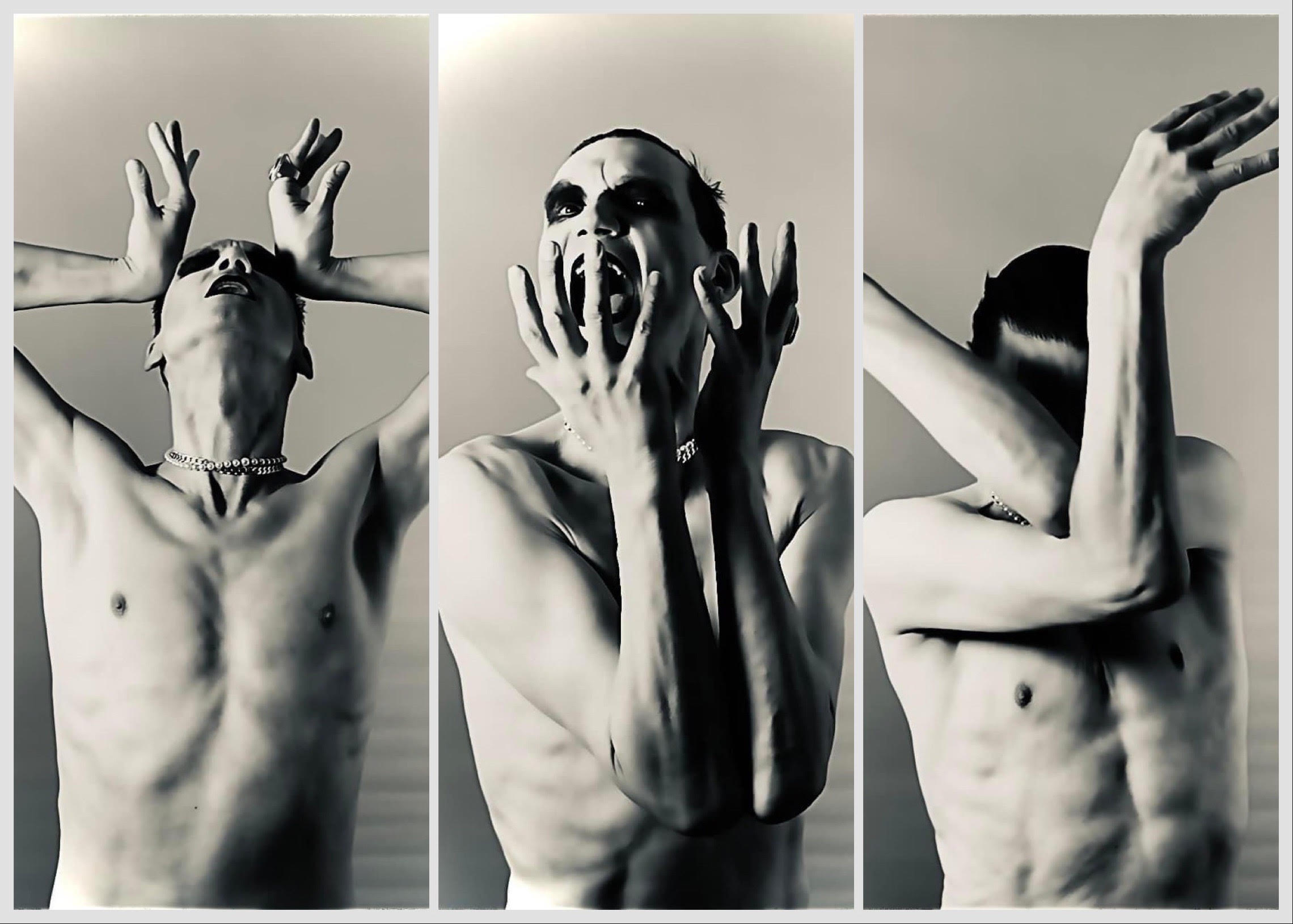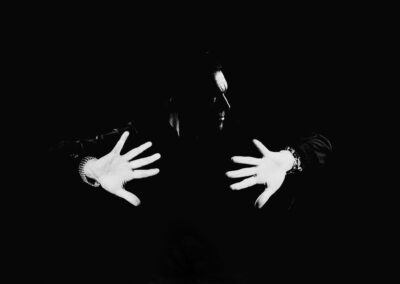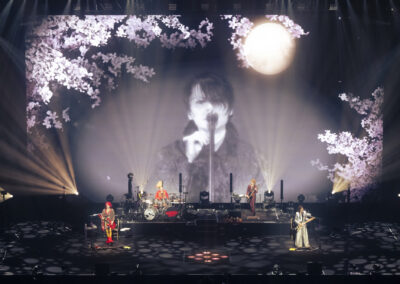Don’t shy away, step into Raymond Watts’ private Red Room, let loose and lose yourself forever and ever!
PIG, spearheaded by the illustrious Raymond Watts, returns with a bang with his highly anticipated album, Red Room. Set for release on May 17th (2024), this new release showcases once again PIG’s mastery in teasing, taunting, tempting, and tantalizing listeners with a unique blend that bears the unmistakable signature of Raymond Watts—a sound both distinct and instantly identifiable. Laden with a sinister allure, glitz, glamour, sleaze, sin, and swing, the album promises an exhilarating sonic journey. Boasting guest appearances from notable artists like Alexis Mincolla (3Teeth), Chris Hall (Stabbing Westward), Chris Connelly (Revolting Cocks, Ministry), Burton C Bell (Fear Factory), En Esch and many more, Red Room delivers a heavenly combination of vocal phrasing, quirky imagery and one-of-kind multi-layered sound. In this exclusive interview, Raymond Watts sheds light on his creative process and his hunger for life.

——Thank you for taking the time to chat with me. How do you feel exactly a few days before the release of your new album Red Room?
Raymond: Thank you for having me, it’s always a pleasure to chat with you. Well, just before an album release, it’s a mixed bag of emotions. I guess, there’s a sense of relief that you’re finally reaching the culmination of a long journey—starting from the inception of ideas for songs, to the meticulous process of crafting them, and then navigating through all the organizational aspects leading up to the release date. It’s like finally seeing the finish line after a marathon. It feels exciting! The release marks the end of one cycle but also sparks thoughts about the next phase—performing the songs live, engaging with the audience, and to be honest, I think my mind is already trying to gather ideas for the next album (laughs). There is a lot going on in there (puts his hands on top of his head).
——Do you care about the reception of your work?
Raymond: Hum… Well, I do. I mean I care about how my work is received. Who wouldn’t want some acknowledgment for their efforts, right? But I’ve learned not to get too caught up in it. I mean, I’m not obsessively checking every review or comment that comes my way. The online world can be a bit of a wild ride, especially nowadays, with social media in the mix. People can be downright savage sometimes. Luckily, I’ve been spared from too much negativity so far. I hope people enjoy what I put out there, but hey, if it’s not their cup of tea, that’s cool too.
——In our last conversation, you said that you release an album only when you have something meaningful to convey. What exactly did you want to convey with Red Room?
Raymond: My new songs embody the current me. They are just the materialization of what’s going on in my head. I felt creative and I wanted to share it. Making music now is a whole different ballgame compared to before. The process has evolved, just like me. My music is a reflection of my ever-changing mind. I also have a great relationship with both my UK and US labels which wasn’t the case before. Back in the 80’s and ’90s, my music emerged from a place of profound darkness and pain. Today, I find genuine joy in what I do and I deeply value the genuine connections I’ve formed with collaborators. In the past, the creative process often felt like a grueling ordeal, marked by intense and extreme experimentation. Before, there was a lot of torment, and my collaborators were just watching. It is as if I were inviting scrutiny into my own suffering in exchange for compensation. It was a weird dynamic, much like being observed and dissected as a specimen in a laboratory rather than being recognized as a fellow human being. Ironically, that’s the essence of my album title, Red Room.
——Can you elaborate on that?
Raymond: Sure! The term Red Room serves as an analogy: people are paying for a front-row seat to my inner turmoil, people are paying to delve into my pain. They are essentially paying to explore my pain. The artist becomes a suffering laboratory rat, with audiences paying to witness the raw agonies within. The term Red Room encapsulates this notion perfectly: people pay to witness dreadful things, embodying voyeurism, pain, and monetary transactions. It delves into the complex and awful system of trading in suffering and reflects on the nature of the artist’s experience. I don’t know…
——That’s a very interesting analogy… It makes me think.
Raymond: Right! I find the term “red room” really appealing because of its alliteration and the way the words sound together. I’m fascinated by the rhythm of language, which is why I’m so drawn to using alliteration. To me, “red room” perfectly captures the emotions and ideas I was experiencing at the time— the complex relationship between pain and money within the realm of being an artist. Also, an album is like a room, a space that reflects what’s going on in my head. The color red is the color of passion and intensity, it mirrors the inner turmoil and depth of emotion within the music. It’s also the color of inside our bodies. So, using the term “red room” was just good way to encompass all these themes and feelings in one phrase.
——And, it does sound great!
You said that you were in a better place but your music is still pretty dark.
Raymond: Well, I think there’s actually a lot of optimism and happiness woven into my current music (smiles). It’s like finding a light at the end of the tunnel; although darkness still lingers. Darkness still exists, as it does in the world. While it may not be immediately apparent, there’s a nuanced interplay between light and dark in my music. It’s about showing hope amidst the complexities of life. I think there is this underlying message of resilience and positivity. I don’t know… This is my happiness (laughs).

——Can you take us through your creative process in crafting this album?
Raymond: Ah ! Answering this question is always a challenge for me because there’s no set formula. I write as inspiration strikes. It’s constantly evolving with both technological advancements and personal growth… It’s influenced by technology, my mood and how ideas manifest within me. The way I approach music now is different from before, yet what remains is that some ideas arrive fully formed in my mind, completely, fully formed. Sometimes, I can visualize the entire song – the melody, lyrics, instrumentation, even the nuances in the middle of the song. But, while sometimes the entire concept of a song materializes in my mind, other times, inspiration strikes unexpectedly from the most mundane sources like watching fucking stupid shit on TV (laughs). Sometimes a song title comes into my head, sometimes it’s the melody, rhythms, words. There is no fixed recipe. It’s like navigating a labyrinth of thoughts and emotions, finding a way to translate them into tangible expressions. It’s about finding a way in and bringing it out… Perhaps now, I find that the inception of a song is often sparked by the lyrics, by words I hear. Previously, melodies took precedence, but now, words seem to ignite my creative ideas… Maybe that’s an age thing (laughs). There’s a lot of elements coming into play to make a record. I see the creative process as the transformation of ideas into tangible form, transitioning from being merely an artist to becoming an artisan—shaping art into physical objects. I get great satisfaction from crafting albums, from giving form to the intangible. Anyway, with so many elements at play, it is still challenging for me to pinpoint a singular answer. I don’t really know how to answer the question.
——You just did perfectly though (laughs).
When do you feel like an album is complete with all the necessary elements in place?
Raymond: Actually, this is probably my biggest challenge. I’ve noticed that many artists set specific goals, like aiming for 8 or 10 songs in an album. But, my approach to music differs. Rather than adhering to a predetermined number, I let inspiration guide me, creating music as it comes to me and refining it until I’m satisfied. As long as inspiration comes my way, I compose. What is challenging is that I constantly grapple with the balance between various elements, ensuring there’s not too much of one thing or an overload of conflicting ideas. A common concern of mine is avoiding an overly cluttered or disjointed sound. I wouldn’t like hearing: “There’s so much going on in this song! There are like five songs in this song!“. This drives me to strive for coherence and cohesion in my music. I’m mindful of not overwhelming people with an explosion of flavors that can’t be easily digested. Reflecting on this analogy, I realize that the most delicious meals are always quite simple with only 2 ingredients in. You know, when I cook—just like when I write music— I put too many fucking ingredients in (laughs). That’s my thing… (smiles).
——But, this is one of the things that make PIG’s music great: the richness of flavors. It’s one of your major strength and definitely contributes to the quality of your music.
Raymond: That’s very nice of you, I appreciate that (smiles).
——Going back to the term red room and the imagery around PIG, do you like being controversial? Do you think controversy is tied to industrial music?
Raymond: Hum (pauses)… I started making music in the late 70s, and now, at 62, I’ve seen how rock has always embraced confrontation and rebellion. Sometimes, to create something new, you have to break down the old. Rock music has always been fueled by noise and confrontation, paving the way for industrial music. It was a time of pushing boundaries. Looking back, some of our actions would stir controversy today (laughs). Sometimes extreme actions are needed to change things, whether in music or wider society, hopefully without too much collateral damage. Actually, I think I lost track of your question (laughs)… Controversy isn’t unique to industrial rock; you can find it in pop music too. Actually, I think a lot of industrial rock is quite conservative.
——Well, when we first met, I was a bit surprised by your kindness and…
Raymond: WhaAaaAt (screams)?! You were surprised (laughs)?! Why is that?
——Yeah, I mean I was a bit nervous about what kind of person I’d be dealing with because of the controversial imagery. But you turned out to be one of the nicest, kindest people I’ve ever met. Don’t you feel like there is a gap between PIG’s controversial “Find it, Fuck it, Forget it” image and Raymond Watts, the gentleman?
Raymond: Oh (smiles)! Absolutely, I do believe there’s a distinction between me as an artist, PIG, and me as a person, Raymond Watts. You brought up “Find it, Fuck it, Forget it” but there’s a crucial aspect that often gets overlooked. The full phrase goes: “You can’t find it, fuck it, forget it forever”. I’m not advocating some sexist notion nor misogynist behavior. Rather, it reflects on what our society has become: use it, throw it away, repeat. It’s a criticism of our consumer society. And that’s why we’re swimming in trash and shit, and fucking things we don’t need. As for the separation between the man and the artist, when I’m writing, it’s just me and my thoughts at home. But when I’m performing as PIG during live, it’s more about putting on a show. It’s like wearing different hats—reflective in one moment, outgoing in another. It’s all different sides of me, aimed at connecting with people. PIG is me and not me. What is for sure is that PIG is always a way for everyone to connect.

——What part of PIG is not Raymond Watts?
Raymond: I sometimes employ personification. I sometimes play a character, just like an actor – delving into aspects of human kind. The act of personification is a tool I’ve used to explore the depths of human nature. Through this lens, I’ve sometimes inhabited the persona as if I were an actor, embodying the darker aspects of humanity. It’s not about identification with those traits but rather a method to vividly portray and confront them, laying them bare for examination. It’s a way to shine a spotlight on these aspects, bringing them into sharper focus for reflection.
——I see, interesting.
Among the spectrum of emotions, which do you find the most powerful to write about? Which emotions resonate the most profoundly with you as a source of inspiration?
Raymond: Hum (reflects)… That’s quite an interesting question. While hunger itself isn’t exactly an emotion, I find the concept of yearning to be profoundly inspiring. It’s that intense desire, that hunger to express oneself and the longing for connection. The sheer act of yearning, a feeling that pulls you forward. It’s like a fire burning within, driving us to reach beyond our limitations. But you know, an emotion is useless alone. What’s most beautiful is that all emotions are intertwined. They’re like threads weaving through the fabric of our experiences. It’s interesting how two seemingly contradictory emotions can actually complement each other, forming the sum of something greater than their individual parts. It’s the complexity and interplay of emotions that make the human experience so profound. Emotions coexist, intricately linked to one another. It’s this interconnection that makes it impossible for me to single out just one emotion that inspires me the most. Each emotion influences and shapes the others, creating a dynamic interplay.
——Much like the yin and yang, they are complementary parts of a whole.
Raymond: Yeah, exactly.
——The album features collaborations with various artists. Which collaboration stood out as the most fulfilling, and why?
Raymond: Well, I’ve collaborated extensively with Jim Davies, known for his work with bands like Prodigy and Pitchshifter. Our collaboration began when he remixed a track for PIG, and I was impressed by his creativity. We gradually started working together more, initially on the previous album and extensively on this one. Jim would send me his ideas, and the synergy between us was fantastic. He’s a fascinating collaborator, and I thoroughly enjoy our work together. I consider our partnership to be the cornerstone of this album. Additionally, I reached out to Burton C. Bell from Fear Factory and Chris Connelly from Revolting Cocks, who contributed vocals on the album. It’s incredibly gratifying to connect with artists you like, and I’m thrilled that they were enthusiastic about collaborating and had a great experience working on the album.
——Do you have a favorite track off of Red Room? Is there any special song to your heart?
Raymond: Oh, that’s like asking me which is my favorite child (smiles).
——And, do you have a favorite child (laughs)?
Raymond: (bursts into laughter) I couldn’t possibly comment (smiles)! Well, one track that stands out to me is Dum Dum Bullet, which involved collaboration from various talented individuals. What I find compelling about this song is it’s the wording and lyrical theme of expansion upon impact, mirroring the way art spreads and grows as it reaches its audience. The analogy of the dum-dum bullet, designed to expand upon impact to cause greater effect, strikes a chord with me. I really like the lyrics and the idea it conveys. Also, I feel a strong emotional connection to all the people who contributed to its creation. But really, I do love them all. Red Room is my favorite PIG’s album.
——Which one was the most challenging to make?
Raymond: One of the most challenging tracks to create was undoubtedly Slave to Pleasure. The complexity lay in the myriad of possible directions it could have taken. There were countless paths we could have explored, each offering its own unique flavor and tone. Deciding on the final direction was no easy task, as we weighed the various options and contemplated the impact of each. But, despite the challenges, the process of piecing together this song was also incredibly interesting. It allowed us to experiment with different sounds, arrangements, and ideas, ultimately leading to a creative experience that was both stimulating and rewarding. Have you listened to the album yet?
——No, not yet. *
Raymond: I’ll send it to you. I hope you’ll enjoy it.
——Oh, thank you. I will, no doubt. *
Raymond: I think Red Room stands apart from my previous albums in several ways. It goes deeper into lyrical content and wordplay rather than relying solely on heavy instrumentation. While some may perceive it as less heavy in terms of musical intensity, its richness lies in the intricacies of its lyrics and the careful crafting of each word. This album is more nuanced manner, emphasizing storytelling and lyricism over sound aggression. It’s different. I hope you’ll like it.
* (ed. notes: VMJ received Red Room by the time the interview was released)
——Thanks again. I definitely will.
Last year, during your time in Japan, we talked about Schwein… Is it OK to talk about it?
Raymond: It’s perfectly fine to talk about Schwein and it’s totally OK to feel sadness and heartbreak over the loss of Atsushi Sakurai (BUCK-TICK). I am grateful for the time we shared together. It has been incredibly difficult. I was genuinely devastated by Atsushi’s passing. While I have experienced loss before, his passing hit me in a different way. A different way! I was shocked and devastated, and it still feels incredibly painful. I truly loved him. Our connection was special, and we had a deep bond. Even though we hadn’t seen each other in years, our friendship remained strong without needing constant maintenance. We were very close in the late ’90s and early ’00s, touring together and collaborating on music in Yokohama. We spent a lot of time together, and there was something truly special between us. He was a great man! I consider myself fortunate to have known such a remarkable person. I will cherish these memories forever.
——I am sure he treasures these moments where he is now.
Last year, there were minimal mention of Schaft in our interview together…
Raymond: I found the Schaft project a very interesting experience as it was my first time collaborating with Japanese musicians. I wrote words, lyrics and melodies into the song structures that Hisashi Imai (BUCK-TICK) and Maki Fuji (Soft Ballet) presented to me so it was no different from my work with bands like KMFDM. I put a couple of songs into the Schaft project that I was going to use for PIG, Imai then added some great guitar textures. I think artists find a way to collaborate (if they’re willing) wherever we come from and the language barrier became a benefit for me because music became the only language we had in common!

——Music is the universal language of humans.
Do you anticipate a possible comeback of Schaft in the future?
Raymond: No, I don’t. The collaboration with Hisashi Imai and Maki Fuji during that time was truly great. I genuinely enjoyed it. Working alongside Hisashi was a stimulating experience. His creative approach is very interesting. Honestly, I would love to work with him again. In fact, we discussed the possibility last year, although it may not be under the Schaft moniker. If circumstances permit, I am open to the idea. Schaft was originally founded by Hisashi and Maki, and they invited me to be a part of it, which I appreciated. We had a memorable tour together. But, the process of creating Schwein held a deeper significance for me. It was a more intimate and personal experience. It involved Atsushi and me sitting together, exchanging ideas and digging into a profound creative connection. That’s where the distinction lies between these 2 bands for me.
——Thank you for this wonderful interview again. I’m grateful for your time and kindness.
Raymond: Thank you Mandah. I had a wonderful time too. Let’s talk again soon.
__________________
Mandah FRÉNOT
(c) VMJ





